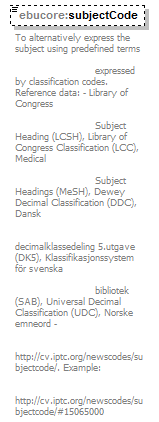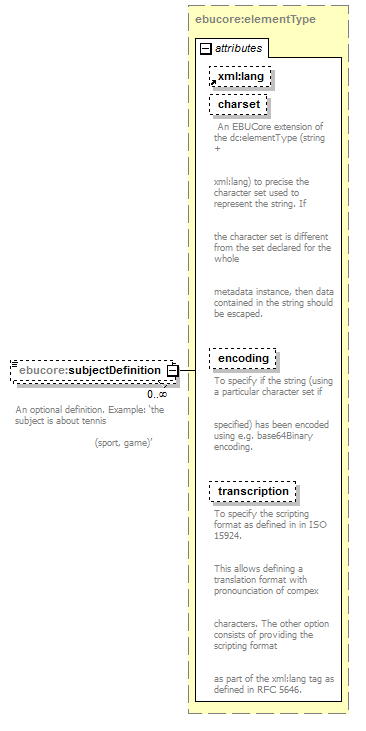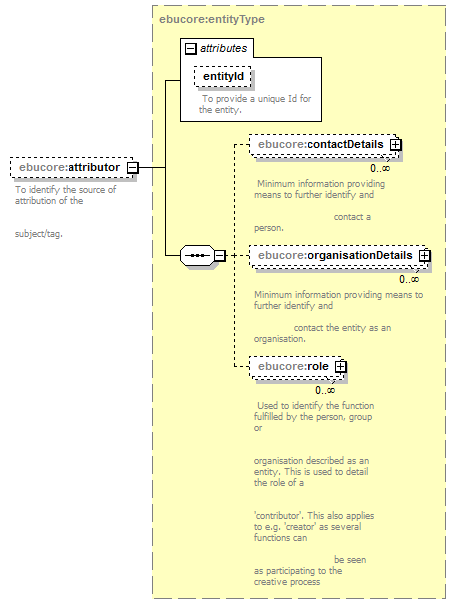| diagram |  |
||||||||||||||||||||||||||||||||||||||||||||||||||||||
| namespace | urn:ebu:metadata-schema:ebuCore_2014 | ||||||||||||||||||||||||||||||||||||||||||||||||||||||
| children | subject ebucore:subjectCode ebucore:subjectDefinition ebucore:attributor | ||||||||||||||||||||||||||||||||||||||||||||||||||||||
| used by |
|
||||||||||||||||||||||||||||||||||||||||||||||||||||||
| attributes |
|
||||||||||||||||||||||||||||||||||||||||||||||||||||||
| annotation |
|
||||||||||||||||||||||||||||||||||||||||||||||||||||||
| source | <xs:complexType name="subjectType"> <xs:annotation> <xs:documentation>The generalised topic of that represents the intellectual content of the resource. Typically, a subject is expressed by keywords, key phrases, or even specific classification codes. Controlled vocabularies, authorities, or formal classification schemes may be employed when selecting descriptive subject terms. It is possible to employ both keywords, derived from a formal classification scheme, such as Dewey or UDC, and genres/subgenres such as those produced by TV-Anytime or Escort, to cover Subject(s) and Genre(s) and enter as appropriate Subject Type below. Persons as subjects are also placed here. Genre of the content is placed under element Type. </xs:documentation> </xs:annotation> <xs:sequence> <xs:element ref="dc:subject" minOccurs="0" maxOccurs="unbounded"> <xs:annotation> <xs:documentation>To express the subject in the form of free text. </xs:documentation> </xs:annotation> </xs:element> <xs:element name="subjectCode" type="anyURI" minOccurs="0"> <xs:annotation> <xs:documentation>To alternatively express the subject using predefined terms expressed by classification codes. Reference data: - Library of Congress Subject Heading (LCSH), Library of Congress Classification (LCC), Medical Subject Headings (MeSH), Dewey Decimal Classification (DDC), Dansk decimalklassedeling 5.utgave (DK5), Klassifikasjonssystem för svenska bibliotek (SAB), Universal Decimal Classification (UDC), Norske emneord - http://cv.iptc.org/newscodes/subjectcode/. Example: http://cv.iptc.org/newscodes/subjectcode/#15065000 </xs:documentation> </xs:annotation> </xs:element> <xs:element name="subjectDefinition" type="ebucore:elementType" minOccurs="0" maxOccurs="unbounded"> <xs:annotation> <xs:documentation>An optional definition. Example: ‘the subject is about tennis (sport, game)’ </xs:documentation> </xs:annotation> </xs:element> <xs:element name="attributor" type="ebucore:entityType" minOccurs="0"> <xs:annotation> <xs:documentation>To identify the source of attribution of the subject/tag.</xs:documentation> </xs:annotation> </xs:element> </xs:sequence> <xs:attributeGroup ref="ebucore:typeGroup"> <xs:annotation> <xs:documentation>To define the source of reference for subject such as a reference document or classification scheme or the framework within which a tag has been attributed.</xs:documentation> </xs:annotation> </xs:attributeGroup> <xs:attribute name="note" type="string"> <xs:annotation> <xs:documentation> Optional additional contextual information. </xs:documentation> </xs:annotation> </xs:attribute> </xs:complexType> |
attribute subjectType/@note
| type | xs:string | ||
| annotation |
|
||
| source | <xs:attribute name="note" type="string"> <xs:annotation> <xs:documentation> Optional additional contextual information. </xs:documentation> </xs:annotation> </xs:attribute> |
element subjectType/subjectCode
| diagram |  |
||||||
| namespace | urn:ebu:metadata-schema:ebuCore_2014 | ||||||
| type | xs:anyURI | ||||||
| properties |
|
||||||
| annotation |
|
||||||
| source | <xs:element name="subjectCode" type="anyURI" minOccurs="0"> <xs:annotation> <xs:documentation>To alternatively express the subject using predefined terms expressed by classification codes. Reference data: - Library of Congress Subject Heading (LCSH), Library of Congress Classification (LCC), Medical Subject Headings (MeSH), Dewey Decimal Classification (DDC), Dansk decimalklassedeling 5.utgave (DK5), Klassifikasjonssystem för svenska bibliotek (SAB), Universal Decimal Classification (UDC), Norske emneord - http://cv.iptc.org/newscodes/subjectcode/. Example: http://cv.iptc.org/newscodes/subjectcode/#15065000 </xs:documentation> </xs:annotation> </xs:element> |
element subjectType/subjectDefinition
| diagram |  |
||||||||||||||||||||||||||||||||||||
| namespace | urn:ebu:metadata-schema:ebuCore_2014 | ||||||||||||||||||||||||||||||||||||
| type | ebucore:elementType | ||||||||||||||||||||||||||||||||||||
| properties |
|
||||||||||||||||||||||||||||||||||||
| attributes |
|
||||||||||||||||||||||||||||||||||||
| annotation |
|
||||||||||||||||||||||||||||||||||||
| source | <xs:element name="subjectDefinition" type="ebucore:elementType" minOccurs="0" maxOccurs="unbounded"> <xs:annotation> <xs:documentation>An optional definition. Example: ‘the subject is about tennis (sport, game)’ </xs:documentation> </xs:annotation> </xs:element> |
element subjectType/attributor
| diagram |  |
||||||||||||||
| namespace | urn:ebu:metadata-schema:ebuCore_2014 | ||||||||||||||
| type | ebucore:entityType | ||||||||||||||
| properties |
|
||||||||||||||
| children | ebucore:contactDetails ebucore:organisationDetails ebucore:role | ||||||||||||||
| attributes |
|
||||||||||||||
| annotation |
|
||||||||||||||
| source | <xs:element name="attributor" type="ebucore:entityType" minOccurs="0"> <xs:annotation> <xs:documentation>To identify the source of attribution of the subject/tag.</xs:documentation> </xs:annotation> </xs:element> |
XML Schema documentation generated by XMLSpy Schema Editor http://www.altova.com/xmlspy